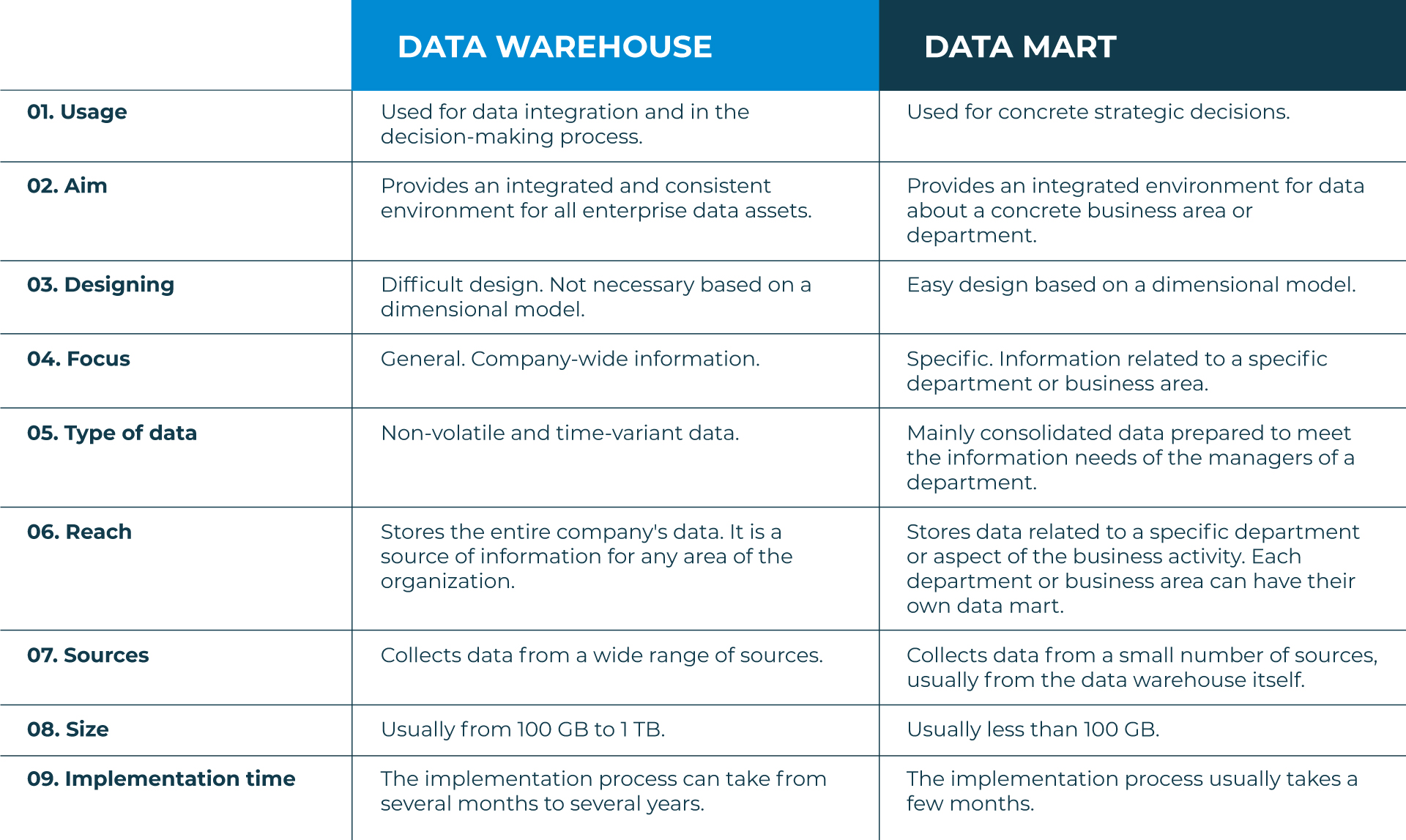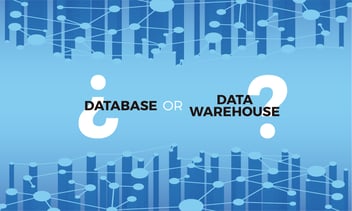In this article we explain the basic definitions and differences between a data warehouse and a data mart, exploring their uses, approach and capabilities.
Databases are part of the basic toolkit of any organization. However, usually only data managers are aware of the differences between the many types of databases that exist. In this article we explain the basic differences between a data warehouse and a data mart for non-experts.

Nowadays it is difficult to find someone who does not know what a database is. Databases are now to the business world what digital whiteboards are to the educational world if they had completely replaced typical chalk boards. However, it is quite normal that within an organization, only technicians, data analysts and data scientists know the differences between the different types of databases and their purposes.
In this blog we have previously discussed the differences between a data warehouse and other databases, as well as the difference between a data warehouse and a data lake. Thus, we have covered the most common databases in the business world, although it is essential to explore data marts, their functions and differences with a data warehouse.
What Is a Data Warehouse?
As the name implies, a data warehouse is indeed a database for data integration. In fact, it usually serves as the central database of a company or, in other words, the database where all the useful data of an organization is stocked.
The peculiarity of the data warehouse is that it is structured to promote the comprehension and organization of the data, which is precisely why it is so widely used in the business world. However, it is not an operational database. In other words, the data integrated into a data warehouse is not intended to be used imminently, but it is stored for future use.
The data stored in a data warehouse comes from multiple sources and in countless formats. Once stored in the data warehouse, it can be organized by topics according to the data consumer's preference and the information is structured into views, processes, dimensions and metrics —usually in star or snowflake schemas—. In addition, a data warehouse has the ability to answer complex queries which resolve doubts about the business activity and serve as a guide when defining strategies and making decisions.
Data warehouses are designed to facilitate data analysis, as they can be integrated with business intelligence tools such as Power BI. At Bismart, as a Microsoft Power BI partner, we work with this tool to offer the best technical capabilities to our customers.
A data warehouse, therefore, is a data store that because of its characteristics converts data assets into understandable, organized, updated and ready-to-be-analyzed information.
What Is a Data Mart?
A data mart is a subset of a database —usually a data warehouse— where data is stored for a specific business area. That is, a data mart stores concise and specific data sets used for analysis for a specific department or line of business, such as the sales department.
The data mart is query-oriented and, as in a data warehouse, the data has a clear structure —also typically star or snowflake dimensional models—. The intent of using a data mart is to index data and facilitate queries about specific areas of the business and to meet the needs of a particular group of users within the organization.
What are the differences between a data warehouse and a data mart?
The main difference between the two databases is their size and approach. While a data warehouse serves as the global database of a business and stores data about any aspect of the company, a data mart stores a small amount of data related to a specific business department or project. Similarly, a data warehouse collects data from a wide variety of sources, whereas a data mart typically collects data from the central database, the data warehouse. This, in turn, means that a data warehouse has a much larger storage capacity than a data mart and a much more complex and difficult to design architecture. In addition, the implementation process of a data warehouse is more complex and time-consuming —it usually takes several months or even years— while that of a data mart can be solved in a few months since it gathers a much smaller amount of data and it has a simpler structure.
Carrying on with the example of the educational system, we could say that a data warehouse is the place where all the documents of an educational center are stored, while a data mart would be the place where each teacher or group of teachers keep the documentation relevant to their subject.
Below, we explore in more detail the main distinctions between a data warehouse and a data mart:

Referring to the main differences between a data warehouse and a data mart, while a data warehouse is used as an organisation's central data repository, a data mart is a more specific data warehouse.
-
A data warehouse facilitates the data integration and general business decision making process of the company, while a data mart assists in more specific strategic decision making.
-
The goal of a data warehouse is to provide an integrated and consistent environment for all of the company's data assets. In contrast, a data mart is an integrated environment for data pertaining to a specific business department.
-
In other words, a data warehouse has a general approach and stores information and data relating to the entire company. In contrast, a data mart has a specific focus and integrates information from a specific business area or department.
-
The design process of a data warehouse is complex and does not have to be based on a dimensional model. On the other hand, the design process of a data mart is easier and is always based on a dimensional model.
-
In terms of data types, a data warehouse contains detailed data that is non-volatile in structure and can vary over time. A data mart, on the other hand, mainly contains consolidated and ready-made data to meet the information needs of department or business area managers.
-
A data warehouse and a data mart are quite different in scope. A data mart is a narrow database, in the sense that it stores data relating to a particular department or aspect of the business. Each department or business area can have its own data mart. A data warehouse, on the other hand, stores data linked to the entire company and to any aspect of the business activity. It acts as a source of information for any area of the organisation.
-
In this sense, a data warehouse collects data from a large number of sources. Typically, a data mart stores data from a small number of sources and, in fact, the main source of origin of a data mart is usually the central data warehouse.
-
data warehouse typically has a size or capacity ranging from 100 GB to 1TB. In contrast, a data mart typically has a capacity of less than 100 GB.
-
Finally, a data warehouse requires an implementation period of several months to several years. In contrast, a data mart can be implemented in a few months.
What are the similarities between a data warehouse and a data mart?
The reason why people often get confused between a data warehouse and a data mart is because they are both data warehouses or databases and therefore have similarities:
-
They Store Data: Both Data Warehouses and Data Marts store data for later analysis.
-
Support Analysis: Both are used for data analysis and report generation.
-
Integrate Data: Both Data Warehouses and Data Marts integrate
What are the advantages of the data mart over the data warehouse?
Advantages of Data Mart over Data Warehouse:
Data Marts have specific advantages over Data Warehouses, especially in contexts where more specialised and agile solutions are needed for certain departments or teams within an organisation. Here are some advantages of the Data Mart over the Data Warehouse:
-
Specific Focus: Data Marts focus on specific areas or departments within an organization, allowing them to be designed and optimized for the particular needs of that department. This leads to better efficiency and relevance for the team using it.
-
Quick Implementation: Due to their limited scope, Data Marts can be implemented more quickly than complete Data Warehouses. This means teams can start using and benefiting from them in a shorter timeframe.
-
Reduced Costs: Due to their smaller size and more focused approach, Data Marts are often more affordable in terms of implementation and maintenance costs. They are a more cost-effective option for teams that do not require the full scope of a Data Warehouse.
-
Ease of Use: Since they are designed specifically for a department or team, Data Marts can be more intuitive and user-friendly for end users. Data is tailored to the needs and knowledge of that specific team.
-
Flexibility: Data Marts are more flexible in terms of data design and structure. They can be optimized for certain types of queries and analyses, making them agile and adaptable to changing business needs.
-
Greater Control: With a more limited scope, Data Marts allow for greater control over data and its access. Individual teams can manage and control their own Data Mart according to their specific requirements.
It's important to note that these advantages are contextual and depend on the particular needs of the organization and the teams utilizing these data management systems.
When to use a data mart instead of a data warehouse?
Using a data mart instead of a data warehouse is beneficial in specific scenarios where the organization's analytical requirements and data management needs are better suited for a more focused and department-specific approach.
Here are some situations when you might choose a data mart over a data warehouse:
-
Department-Specific Analysis: When individual departments or business units within an organization have unique and specific analytical needs that are distinct from other parts of the organization, data marts can provide a dedicated solution tailored to those requirements.
-
Simplified Data Model: Data marts often have a simplified and denormalized data model optimized for specific business questions or reporting needs. This design simplifies the data structure, leading to faster query performance and easier data consumption for end-users.
-
Faster Implementation: Data marts can be implemented more quickly and with less effort compared to building a comprehensive data warehouse. They can be set up to address immediate analytical needs, especially when time is of the essence.
-
Agility and Flexibility: Data marts offer greater agility and flexibility in terms of adapting to changing business requirements. Since they are smaller in scope and focus on specific subject areas, they can be adjusted or expanded more easily as analytical needs evolve.
-
Data Security and Access Control: Data marts can be designed with specific data security measures, ensuring that sensitive data is limited to authorized users within a particular department. This level of control is especially important when certain data needs to be restricted to specific users or groups.
-
Cost-Efficiency: Building a data mart can be a cost-effective solution when the organization's analytical needs are department-specific and do not require the resources and complexity of a full-scale data warehouse.
-
Business Unit Autonomy: Data marts allow individual departments or business units to have more autonomy over their data and analytics, enabling them to focus on their unique requirements and goals.
It's important to note that data marts are not mutually exclusive with data warehouses; they can coexist within a broader data management strategy. In some cases, organizations adopt a hybrid approach, where they have both a data warehouse and multiple data marts. The data warehouse serves as a centralized repository for enterprise-wide data, while data marts provide specialized views of the data tailored to specific business units.
The decision to use a data mart instead of a data warehouse is based on the organization's specific analytical needs, resource constraints, and the complexity of data management requirements within individual departments or business units.
Example of a data mart
Example of a Data Mart in a Retail Company:
Let's imagine a large retail chain with a nationwide presence. The company aims to enhance inventory management efficiency and gain a better understanding of purchasing trends in different regions of the country to optimize stock and improve customer satisfaction. To achieve this, the company could implement a specific Data Mart for its sales and logistics department.
What would the Data Mart contain?
Sales Data: It would include detailed information on sales transactions, such as purchased products, quantities, prices, dates, and store locations.
Inventory Data: It would contain data on inventory levels in each store, including information on stocked products, out-of-stock products, and upcoming deliveries.
Demographic Data: It could include demographic data of customers in different regions to better understand purchasing preferences based on location.
Climate Data: To analyze how weather conditions affect the sales of certain products in different geographic areas.
Supplier Data: Information about the company's suppliers, delivery times, and product quality.
What is the purpose?
Inventory Optimization: By analyzing the data from the Data Mart, the company can forecast demand in different regions and adjust inventory levels accordingly, avoiding excesses or shortages.
Trend Analysis: By analyzing purchasing patterns based on demographic and climate data, the company can tailor its offerings to meet the specific demands of each region.
Improved Purchasing Decisions: By gaining a better understanding of which products are popular in which regions and at what times of the year, the company can make more informed decisions when purchasing inventory from suppliers.
Customer Satisfaction: By avoiding shortages of popular products and ensuring a suitable variety in each store based on local preferences, the company can enhance customer satisfaction and foster brand loyalty.
This example illustrates how a specific Data Mart can be an invaluable tool for a retail business, providing detailed and specific information for making strategic decisions that benefit both the company and its customers.
In short, a data warehouse is a central database with the ability to connect to virtually any data source and with large storage capacities. A data mart, on the other hand, is a sub-area of a data warehouse, with reduced storage capacity and oriented to solve the doubts of data consumers regarding a specific area of the business.



